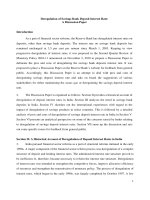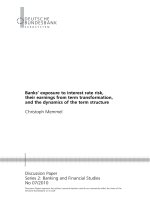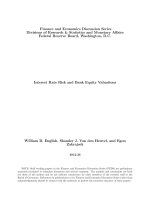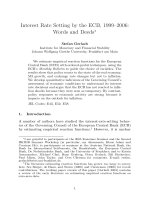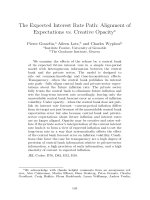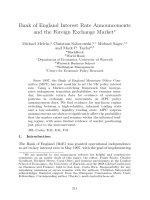REGULATION OF INTEREST RATE BY THE STATE BANK OF VIETNAM (SBV) potx
Bạn đang xem bản rút gọn của tài liệu. Xem và tải ngay bản đầy đủ của tài liệu tại đây (157.57 KB, 20 trang )
GROUP ASSIGNMENT
International Finance
REGULATION OF INTEREST RATE
BY THE STATE BANK OF VIETNAM (SBV)
Group Members:
Pham Duc Trung
Vu Hieu Trung
Phan Tung Nguyen
Nguyen Thu Phuong
Tran Quoc Loc
English Speaking Group 2
Intake 13
CFVG Hanoi
HANOI, JUNE 2006
id11486812 pdfMachine by Broadgun Software - a great PDF writer! - a great PDF creator! -
International Finance
Regulation of Interest Rate by the State Bank of Vietnam (SBV)
Page 2 of 20
Table of Contents
F
OREWORD
3
1. T
HE
R
OLES OF
I
NTEREST
R
ATE
4
1.1
Interest Rate and Consumption/Investment 4
1.2
Interest Rate and Inflation 5
1.3
Interest Rate and Exchange Rate/Trade Balance 5
1.4
Interest Rate and the Financial Market 5
1.5
Balance Among Factors 6
2.
T
HE
I
NTEREST
R
ATES
R
EGULATING
M
ECHANISM BY
SBV 8
2.1 The shock of interest rates during 1990s 8
2.2 Basic Rate – Period from June 2000 – May 2002 9
2.3 Freely Negotiable Interest Rate – Period from June 2002 up to now 9
2.4 Interest Rate and the Stability/Development of Financial Market 13
2.5 Balance among three Objectives of Inflation Control, GDP Growth and the Stability
of Financial Market 14
3. R
ECOMMENDATION FOR
SBV
TO
R
EGULATE
I
NTEREST RATE
17
3.1
Improve the current regulating mechanism 17
3.2
Set up and perfect indirect monetary tools 18
3.3
Determine clear objectives of monetary policy 19
R
EFERENCE
20
International Finance
Regulation of Interest Rate by the State Bank of Vietnam (SBV)
Page 3 of 20
F
OREWORD
We would like to present to you our study on the Regulation of Interest Rate by the State
Bank of Vietnam (SBV) as our team’s assignment for the course of International Finance,
CFVG, Hanoi, Vietnam. We hope that this study can give you some information and analysis
on the monetary policies of Vietnam. We would like to express our sincere thank to Dr.
Michel Henry Bouchet, for his lessons and guidance during the course.
Pham Duc Trung
Vu Hieu Trung
Phan Tung Nguyen
Nguyen Thu Phuong
Tran Quoc Loc
MBA Intake 13
CFVG, Hanoi, June 2006.
International Finance
Regulation of Interest Rate by the State Bank of Vietnam (SBV)
Page 4 of 20
1. T
HE
R
OLES OF
I
NTEREST
R
ATE
Interest Rate is a key economic factors, which have close relations with other factors.
In this section, we will study such relation and the level of interaction between interest rate
and other factors in Vietnam.
1.1 Interest Rate and Consumption/Investment
Interest rate and consumption:
Because the consumption is by individual and households and the borrowing for
consumption is very low in Vietnam, it relates more closely with the deposit interest rate, than
the lending rate. If the REAL DEPOSIT interest rate is high, people tend to save more money
in deposit, rather than spending.
On the other side, if the consumption is high, the income available for saving is low,
and the banks have to increase deposit interest rate to get more deposit.
Interest rate and investment:
In respect of investment, it concerns more about businesses, who increase their
investment if they can borrow money at low REAL LENDING interest rate. In Vietnam,
where bank loans are major local sources of financing investment, interest rate is very
important for investment. On the other side, if the investment is high (e.g. in booming
economy), banks demand more money by increasing DEPOSIT rates, while increase
LENDING rates to compensate and get profits from the investors (who are hungry for
money).
Collectively, a low real interest rate will boost consumption and investment, which
results in the growth of [HOT] economy; while a high real interest rate tends to COOL the
economy. Empirical evidence in Vietnam shows that, when the effect of inflation is removed,
the Real GDP goes in opposite direction against Real Interest Rate.
-4
-2
0
2
4
6
8
10
12
2000 2001 2002 2003 2004 2005
Real GDP Growth Rate (%)
6.2
6.4
6.6
6.8
7
7.2
7.4
7.6
7.8
Real Interest Rate (%)
Real Interest Rate - Three-month deposits (households)
Real Interest Rate - Short-term lending
Real GDP (annual percentage change)
International Finance
Regulation of Interest Rate by the State Bank of Vietnam (SBV)
Page 5 of 20
1.2 Interest Rate and Inflation
Following the quantity theory of money, as the interest rate increases, the money
supply decreases, and the price tends to decreases to balance the equation of quantity theory
of money (MV ≡ PV). In addition, an increase in interest rate will cause both the consumption
and investment demand to decrease as discussed above, which results in the decrease of
aggregate demand of economy, and a lower equilibrium price can be expected due to the
move of demand curve to the left.
However, this effect seems to be SHORT-TERM because the decrease of investment
will finally result in the decrease of supply (decrease of T), which in turn moves the supply
curve to the left and bring the price back to the first equilibrium position.
M x V = P x T
(1)
(2)
(3)
(4)
Price
Quantity
P1
P2
D1
D2
S1
S2
1.3 Interest Rate and Exchange Rate/Trade Balance
In an open-door market, the interest rate also greatly affects the exchange rate and
trade balance of country. If the interest rate of one country is high, it attracts the capital
inflow, which results in the increase of foreign currency supply; this in turn increase the local
currency value and import, while discourages the export.
Generally, the above-mentioned relationships work well in a developed economy. But
in developing world, the inefficiencies of financial market and the irresponsiveness of
economy usually limit the relationships. Especially for Vietnam, where there are still many
restrictions on the capital flow and foreign exchange transaction, the interaction between
interest rate and exchange rate is limited.
1.4 Interest Rate and the Financial Market
In this study, the financial market is defined as the middle-man between the saving (S)
and the investment (I), which brings the unused capital to the investors. In this market, the
interest rate can be considered as the price of money, which plays a critical role in
competition among the banks.
Deposit side vs. Lending side:
The utility package offered by the banks to the depositors mainly includes the interest
rate, the quality of service, and the credibility. If the banks can not compete with higher
International Finance
Regulation of Interest Rate by the State Bank of Vietnam (SBV)
Page 6 of 20
service quality and creditability, the only weapon for competition is the interest rate. In
addition, a bank with low service quality and creditability usually offers high deposit interest
rate. This is really the case for Vietnam, where all the state-owned banks offer lower deposit
rate than private banks, but they can get much more deposits than the private banks, because
the creditability of state-owned bank is very high (no failure due to the Government’s
support), while private banks are fiercely competing with each other for deposits. Please refer
to the following table for the current deposit interest rate (May, 2006) of three biggest state-
owned banks and private banks.
State-owned Banks Private Banks
Deposit Interest
Rate (%)
VCB ICB BIDV ACB SACOMBANK TECHCOMBANK
Time - 3 months 7.44
7.56
7.56
8.16
8.52
8.40
Time - 6 months 7.80
7.80
7.80
8.40
8.76
8.64
Time - 9 months 8.04
8.16
8.04
8.58
9.06
9.00
Time - 12 months 8.40
8.40
8.40
8.40
9.18
9.24
Time - 24 months 9.00
9.00
9.00
9.12
9.78
9.72
Time - 36 months 9.12
9.12
9.12
9.36
9.96
It is also noted that the interest rates of all state-owned banks are nearly same.
On the other hand, the utility package offered by the banks to the investors mainly
includes the low cost of capital, service quality, the quality of loans (in term of availability,
flexibility, and amount). In addition to the quality of investment/loans and service quality,
lending interest rate is also a key competition factor. However, because there is more
differentiation, and the banks’ bargaining power is stronger on the lending side, the
competition force is always fiercer on the deposit side.
Interest Rate and Financial Crisis:
There is always a force to push the banks to race for the higher deposit and loan
amount, and to capture the bigger market share. To obtain high deposit amount, the bank may
increase the interest rate of deposit. With the big amount of deposit obtained, the bank can
also offer good quality of loans, and gain more and more power on the lending side (in term
of availability, flexibility and amount).
On the other side, to release the captured deposit, the banks can not increase the
lending interest rate too high. The “price war” of interest rate is always a danger for the
banking system, because it deduces the margin (lending rate – deposit rate – operation
expenses) and it can lead the banking system to crisis. In Vietnam, the failure of some small
banks (or small credit institutions) in 1990s is one bloody experience of this type.
1.5 Balance Among Factors
As discuss above, the interest rate interacts with other economic factors: (i)
consumption/ investment (or collectively GDP); (ii) inflation; (iii) exchange rate; (iv) stability
of financial market.
International Finance
Regulation of Interest Rate by the State Bank of Vietnam (SBV)
Page 7 of 20
As the Central Bank of Vietnam, SBV always try to find out a balance to monitor the
interest rate. Based on the degree of interaction between interest rate and other factors, SBV
can generally pursuit following policy:
a) Liberalizing Interest Rate: This is an irreversible trend for many countries in the
world, because it can help allocate resources (money) effectively and efficiently. This is one
of the reforms suggested by John Williamson, 1989, in his so-called “Washington
Consensus”;
b) Prevent harsh “price war” of interest rate in Banking System, to prevent failure of
banking system (crisis of the Financial Market);
c) Keep an eye on the inflation; in the case of Vietnam, this may be to control the
inflation rate of one-digit;
d) Given the above constraints, the real interest rate should be low enough to keep
high GDP growth, because the real interest rate has a strong relation with consumption and
investment as discussed above.
We will discuss more deeply into these policies in next part.
Inflation
Stability
of
Financial
Market
Exchang
e Rate
Consump
tion/Inve
stment
Real
Interest
Rate
International Finance
Regulation of Interest Rate by the State Bank of Vietnam (SBV)
Page 8 of 20
2.
T
HE
I
NTEREST
R
ATES
R
EGULATING
M
ECHANISM BY
SBV
In transition from the command economy to the market economy, Vietnam has gone
through many changes in the regulating mechanism to liberalize the interest rate from 1992 up
to now. Even, in this study, we will concentrate on the period from 2000 up to now but we
will take a look for the interest rates situation in Vietnam from during the period from 1994 to
1997 when the Vietnam economy has been shocked because of the wrong interest rates policy
2.1 The shock of interest rates during 1990s
In 1994, instead of lowering the interest rate according to the policy adopted by the
Conference of Bankers at the beginning of the year, the State Bank preserved the status quo
on the grounds that the inflation rate in the first half of 1994 had shown a tendency to become
higher by the second half than what had been planned by the National Assembly.
In 1994, the inflation rate reached 14.4%, and the real interest rate was: 25.2%-14.4%
= 10.8%. Many commercial banks had even offered much higher deposit rates (from 32% to
36% a year) and caused the real interest rate to increase to 18-22%, therefore it's obvious that
the state Bank should have reduced the interest rate in 1994. In 1996, the State Bank reduced
the interest rate four times and caused a lot of losses to commercial banks. The first joint
stock bank in Vietnam, by publicizing its balance sheet, had to admit that its interest in black
was lower than its interest in red.
Up to now, there is no answers to such questions as how many joint stock banks had to
suffer losses because of the reductions of the interest rate and how many banks had to violate
regulations on interest rates with a view to saving themselves from losses. Bits of information
gathered in 1996 showed that rural joint stock banks had to increase the deposit rate to 1.6-
1.7% a month, thus they had certainly been allowed to violate the interest rate-ceiling of
1.5%. A branch of foreign banks has violated the regulation on interest rate-ceiling by
requiring local banks to deposit 50% of loans supplied by this branch, thus it has doubled the
lending rate on loans in foreign currencies. This branch, therefore has avoided the danger of
bad loan because it held 50% of the loan supplied.
Calculations publicized by the press showed that in 1996 banks had to suffer losses
because even if they could lend 80% of their deposits, they couldn't collect enough interest on
loans to cover their interest in red, that is, their overheads became losses. In July 1997 when
the interest rate-ceiling was reduced, no attention was paid to losses suffered by joint stock
banks. If they observe the bank margin of 0.35%, the deposit rate will be only 0.65% and
become unattractive, therefore joint stock banks have to offer a deposit rate of 0.8-0.85% to 3-
month deposits, and raise bank charges in order to reduce potential losses.
Let's study an example: With deposits of 100 billion, a bank has to pay 0.8-0.85%
interest, or 80-85 million. If it can lend 80 billion (this is rarely seen in reality) and receives
interest at 1%, or 80 billion, it will certainly suffer losses because it has to pay the overheads.
The loss will be bigger if it pays 0.85% interest on deposit. Only State-owned commercial
banks (except for banks for agriculture) can avoid losses because its call deposits represent
over 50% of its total deposits. Strange to say, the State Bank has paid no attention to this
situation although many bankers at the conference have given voice to the regulation on
International Finance
Regulation of Interest Rate by the State Bank of Vietnam (SBV)
Page 9 of 20
interest rate-ceiling. The State Bank has thought that joint stock banks as well as state owned
bank had to suffer losses in order to carry out the regulation on interest rate. In order to avoid
losses and bankruptcy, joint stock banks have to find ways to increase the lending rate. One of
alternatives is to follow in footsteps of the branch of foreign bank as stated above. When the
interest rate-ceiling is reduced, it's necessary to help joint stock companies to avoid losses.
When the central bank wants to encourage the economic development, it will lower
the interest rate, whereas the interest rate-ceiling in Vietnam was fixed by the Government in
this period, so the central bank has to use administrative measures to enforce it, however, the
regulation didn't provide for subsidies given to banks suffering losses, therefore all officials
from the central bank tended to pay no attention to the fact that joint stock banks had raised
the lending rate. That was why many rural banks have officially offered the deposit rate of
1.6-1.7%.
2.2 Basic Rate – Period from June 2000 – May 2002
During this period, the SBV sets a promulgated interest rate, called “Basic Rate” and a
bandwidth. The basic interest rate affects all other interest rates arising in the market
economy. It is a kind of interest rates playing an important role in the market mechanism in
general and our market economy in particular. The basic interest rate is determined by the
central bank and announced on the basis of real situation and targets of the national monetary
policy. The point 12, Article 9 of the Law on the State Bank of Vietnam stipulates: " The
basic interest rate is the interest rate announced by the State Bank of Vietnam making a
ground for credit institutions to fix their business interest rates". However, it is argued that the
basic interest rate is a broad concept including different rates of capital re-allocation,
rediscount, interbank market; maximum rate for loans and minimum rate for deposits.
Other banks can set their own interest rate for local currency loans, but it is not
allowed to be higher than the sum of basic rate and bandwidth. The bandwidth for local
currency is 0.3% for short-term loans, and 0.5% for mid-term and long-term loans.
For foreign currency, the interest rate for short-term loans shall not be higher than 3-
month SIBOR+1%; and the interest rate for mid-term and long-term loans shall not be higher
than 6-month SIBOR+1%.
This regulating mechanism is rather free for other banks to set their own interest rate.
The credit expansion capability of banks is released to finance the economy, particularly by
the long-term loan. This mechanism allows the banks to manage their own strategies and
operation better than the previous. However, the basic rate and the bandwidth are set by the
SBV subjectively, and not in line with the actual conditions of money supply – demand. The
regulating tool is completely administrative, and the market forces have limited effects on the
interest rate.
Therefore, the mechanism has been replaced by negotiable mechanism on June 2002.
2.3 Freely Negotiable Interest Rate – Period from June 2002 up to now
From June 2002, the interest rate was freely negotiable by the new policy of SBV that
“the banks can fix their own interest rate on loans on the basis of market capital supply –
demand and the creditability of borrowers”.
International Finance
Regulation of Interest Rate by the State Bank of Vietnam (SBV)
Page 10 of 20
This new policy has completely freed the market interest rate. The SBV no longer
control the interest rate directly, but they start to use many indirect tools, including required
reserve ratio, basic rate, refinancing and discount rate, open market operation.
Required Reserve Ratio:
The required reserve ratio can be set between 0 – 20% as required by the Law on State
Bank. However, the actual ratio set by SBV is too low to have considerable effects on the
money supply:
Required reserve ratio Types of financial institutions
Dec 2002 Aug 2003 Jul 2004
State-owned banks, Urban banks, Foreign bank branch 3% 2.0% 5%
Rural banks 2% 1.5% 4%
Others 1% 1.0% 2%
In July 2004, SBV increase the required reserve ratio by 1 – 3%. This is an action to
control the inflation. Theoretically, other banks have to increase the loan interest rate to offset
the loss of revenue due to additional “dead money” retained in their reserve account at SBV,
otherwise their profit ratio will be reduced. However, in July 2004, the interest rate in the
market is as high as 11% - 14% per year, and the SBV pays interest rate on the required
reserve amount (SBV does not pay interest on the reserve in excess of requirement).
Therefore, the market interest rate has not increased as expected.
Though the theory suggests that an increase in the required reserve ratio will result in a
decrease of money supply, there seem to be no clear correlation between the two in Vietnam.
This may be explained by the fact that banks usually retain more money than the required
reserve ratio (this is a usual phenomenon of developing countries). Another reason is that the
required reserve ratios is rather low, and even the increase by 3%, the ratio is only 5% in
comparison with a common 7 – 10% for developing countries. Therefore, the required reserve
ratio should not be highly appreciated as a tool for regulation of interest rate if it is not
increased to a more meaningful level.
Basic rate:
From June 2002, the basic rate is no longer compulsory for other banks, but it serves
as a “guiding indicator” for the market interest rate. It is calculated based on the interest rate
of 15 biggest banks for the best investors. Following figure is the moving trend of basic rate
in comparison with the market rate.
International Finance
Regulation of Interest Rate by the State Bank of Vietnam (SBV)
Page 11 of 20
0
2
4
6
8
10
12
2000 2001 2002 2003
Interest rate (%)
Deposit i
Auctioned i for treasury bill
3-month i on inter-bank market
Buying i on open market operation
Short-tem i on loan
Basic rate
As shown on the figure, the market rate tends to increase, but the basic rate is set to
decrease. Therefore, “basic rate” can not serve as a “guiding indicator” for the market interest
rates. This is a direct outcome of policy change to the freely negotiable interest rate.
Such administrative tool as basic rate is now obsolete and causes no effect. Therefore,
the basic rate should not be used by SBV as a regulating tool any more.
Refinancing and Discount rates:
From March 2003, SBV established two rates to guide the market interest rate, say
“refinancing rate” and “discount rate”. The discount rate is used in coordination with the
discount quotas set by SBV for each bank on monthly basis.
The refinancing rate and discount rate is intended to serve as the “ceiling” and “floor”,
respectively, for the inter-bank rate (including for open market operation), but it is shown in
following figure that both the intended ceiling and floor rate are lower than other rates.
0
2
4
6
8
10
12
2000 2001 2002 2003
Interest rate (%)
Refinancing i
Discount i
Deposit i
Auctioned i for treasury bill
3-month i on inter-bank market
Buying i on open market
International Finance
Regulation of Interest Rate by the State Bank of Vietnam (SBV)
Page 12 of 20
One positive sign is can be seen that the trends of inter-bank interest rate moving in
the same direction as that of discount rate. The limitation of effectiveness of these tools in
regulating the market deposit/loans may be explained by the competition force as later
discussed.
A recent development in early 2005 also justifies for the usefulness of these tools. On
15 January 2005, SBV increased both the refinancing and discount rates by 0.5% (from 5% to
5.5%, and 3% to 3.5% respectively). One 1 April 2005, SBV increase the rates for the second
time by 0.5% in an effort to prevent the high inflation rate of 9.5% for the year 2004, 1.1% for
January 2005, and 2.5% for February 2005.
Following this action, both the inflation and the market interest rate show responsive
movements. The inflation rate in is decreased to 0.1% per month, and the market interest rate
has increased by 0.36% - 0.96%.
Based on this study, and the theory of discount rate, we consider it should be better to
use the discount rate as a major tool to regulate the interest rate. However, some following
ideas may be considered to make it more effective:
- Do not take the refinancing rate as the “ceiling rate”, because principally, the
refinancing rate and the discount rate save only the outflow of money from the
SBV to the other banks, which results in the increase of money supply and the
interest.
- Do not use the discount quotas as a limitation on the amount of discounts. This
quota is both discriminated and limit the power of SBV on the money market.
Open Market Operation:
Open market operation has well developed from August 2000 to become an important
tool for SBV to regulate the money supply and interest rate. Following is the dramatic growth
of transaction in the open market operation:
0
5000
10000
15000
20000
25000
30000
35000
40000
45000
2000 2001 2002 2003
Billion VND
Total transaction of open market operation
SBV bought
SBV sold
International Finance
Regulation of Interest Rate by the State Bank of Vietnam (SBV)
Page 13 of 20
Basically, all the necessary procedures for mature open market operations have been
developed. However, these operations grow mainly by the quantity rather than quality. The
main players are the state-owned banks (more than 95% of transaction). About 30% session is
failed, and the means of transaction (bond) is only limited to treasury bonds and deposit
certificates. Other medium-term and long-term bonds have not be put on the stage. The
auction is based more on the volume rather than the interest rate.
Therefore, the open market operation does not reflect the money supply – demand in
the market, but only the exchange the quantity among the state-owned banks. From this view,
a comprehensive plan should be developed to improve the effectiveness of open market
operation as a major tool for regulating money supply and interest rate:
- Developing the inter-bank market to establish an environment for the open market
operation and to guide the interest rate for the open market operation;
- Release the medium-term and long-term bond for the open market operation;
- Encourage all the banks and financial institutions to join the auctions of open
market operation by offering attractive packages.
Generally, the regulating tools used by SBV have been approaching the modern
mechanism for a free market. Though the effectiveness of these tools is still limited, the
positive signs can be seen, particularly for the discount rate and open market operation.
2.4 Interest Rate and the Stability/Development of Financial Market
After the change of policy toward a system of freely negotiable interest rate, there is
tense competition in the financial market, which raises many concerns. Please refer to the
following figures for the market share of different types of banks in Vietnam, and that of four
biggest state-owned banks.
Share of different types of Banks
65.0%
13.0%
0.6%
21.4%
State-owned bank
Urban Commercial Banks
Rural Commercial Banks
Foreign Bank Branchs
International Finance
Regulation of Interest Rate by the State Bank of Vietnam (SBV)
Page 14 of 20
Shares of 4 biggest state-owned banks
16.1%
11.6%
10.6%
9.1%
52.7%
Agribank
BIDV
Vietcombank
ICB
All other banks
It is clearly shown on the figures that the state-owned banks are dominant (65%) of the
financial market. One key feature is that the four biggest state-owned banks have quite similar
market share (16.1% - 11.6% - 10.6% - 9.1%), therefore, the competition tends to be high.
Recently, these four banks have formed many syndicates to finance big projects, which is may
be a sign of “cartels” to ahead the growing power of strong foreign banks, which are
penetrating the market recently. There is also a high tensile between the banking industry and
the informal financial middle-men, who account for about 25% of the overall financial
market.
Due to these facts, the competition is high, and a race of interest rate is an immediate
danger for the stability of financial market. Therefore, the SBV is always aware of the risk for
financial market in determining the interest rate policies.
2.5 Balance among three Objectives of Inflation Control, GDP Growth and the
Stability of Financial Market
As discussed in Part 1, the interest rate has a direct relation with the consumption and
investment, which in turn relate directly to the GDP (Y). It also has close relations with the
inflation and foreign exchange / trade balance.
In this part, we will study two factors which serve as the final objectives for the
Central Bank to regulate the interest rate, i.e. GDP growth and Inflation
1
. Following figure
shows movement trends of interest rate, GDP growth, and inflation in Vietnam from 1999 –
2003.
1
In Vietnam, the external factors of foreign exchange / trade balance seem to have little relations, because the
inflows/outflows of capital is strictly controlled by the Government. For example, the foreign indirect investment
(FII) is largely prohibited, only several trust funds are permitted to operate within limited scope; the foreigner
are only permitted to purchase upto 30% of the local companies under strict conditions; the bonds are only
permitted to issue oversea under strict conditions. Therefore, an increase in the interest rate can not attract the
inflows of foreign currencies (say, increase demands for local currency) to increase the value of local currency
(exchange rate).
International Finance
Regulation of Interest Rate by the State Bank of Vietnam (SBV)
Page 15 of 20
-1
0
1
2
3
4
5
6
7
8
1999 2000 2001 2002 2003
Annual growth rate % (GDP, Inflation)
0
1
2
3
4
5
6
Interest rate %
GDP growth rate
Inflation
Discount rate
As discussed in Part 1, the higher the interest is, the lower GDP and the higher the
inflation rate is. However, in almost all economies, there are always objectives of higher GDP
growth rate and lower the inflation rate.
As we can see in the above figure, during 1999 – 2003, Vietnam seems to archive both
targets of high GDP growth rate and low Inflation rate. Please note that during this period,
Vietnam and the South East Asia had just got out of the financial crisis in 1999. Therefore, the
SBV has applied an “easy monetary policy”, trying to lower the interest rate to foster the GDP
growth. Partly thank to this policy, the money has pumped into the economy at the increase
rate of 17.6 – 39% per year (increase of M2), and the total loan has increase by 21.4 – 38.1%.
In 1999 – 2003, the inflation rate is very low as of 0.1% in 1999, -0.5 in 2000
(deflation). Therefore, there is no danger of high inflation rate, and an “easy monetary policy”
is very useful to push up the GDP growth rate and increase the Inflation rate to a more safety
level. During this period, the objective of GDP growth rate is in line with the objective of
controlling inflation rate.
However, in the year 2004, the Inflation rate is as high as 9.5%, and a true tension
exists between the objective of GDP growth and the objective of controlling inflation rate.
Following figure shows the month inflation rate from 2003 up to now.
International Finance
Regulation of Interest Rate by the State Bank of Vietnam (SBV)
Page 16 of 20
Consumer Price Index (Monthly)
-1.00%
-0.50%
0.00%
0.50%
1.00%
1.50%
2.00%
2.50%
3.00%
3.50%
J
a
n
-
0
3
M
a
r
-
0
3
M
a
y
-
0
3
J
u
l
-
0
3
S
e
p
-
0
3
N
o
v
-
0
3
J
a
n
-
0
4
M
a
r
-
0
4
M
a
y
-
0
4
J
u
l
-
0
4
S
e
p
-
0
4
N
o
v
-
0
4
J
a
n
-
0
5
M
a
r
-
0
5
Sources: General Statistics Office; Please note that the inflation rate in Vietnam has a seasonal peak
from November to February due to high consumption around the New Year Holiday.
For the year 2004, the SBV has try several tools to reduce the inflation rates, which
include increasing the required reserve ratio (July 2004), stabilization of exchange rate
(August 2004), issuing treasury bonds (September 2004). Especially, in January 2005, SBV
has shown a strong action to increase the discount rate and refinancing rate by 0.5% per year,
associating with intensive open market operation. On April 2005, SBV increase against the
discount rate by 0.5% to 4.0%. These strong actions seem to be effective in controlling the
inflation rate down to 0.1% in March 2005, particularly after the regulation by the tools of
discount rate and open market operation.
Right after the second-time increase of interest rate by SBV, Vietcombank – a leader
of the financial market – has started to increase its deposit interest rate on 5
April 2005. As
explained by the Vietcombank’s executives, the banking industry is under a hard time to
obtain the deposit amount. Due to the high inflation, if the banking industry does not increase
the deposit interest rate, the net interest rate may be negative (interest rate < inflation rate).
Therefore, in the year 2004, the increase rate of total loan amount is much higher than that of
total deposit (Vietcombank: loan amount increased by 23%, while the deposit amount
increased by only 11.3%; ICB: 11.6% against 2.3%). The increase rate of deposit amount for
the last 3 months (January – March 2005) is only 1%, and the bank has no other choice but to
increase the interest rate. Under same pressure and leaded by Vietcombank, other banks will
surely increase their interest rate.
At this time, probably the banks will take chance to run for the deposit and bigger
market share, because of the high competition in the financial market, as discussed above. In
respect of the effects on GDP growth, please note that the current loan interest rate is rather
high, the lowest loan rate is about 8.8%, the average is about 10.5% and the highest is 16.2%.
Therefore, an increase in loan rate will result in negative effects on the GDP growth, and the
target of 8.5% GDP growth will be hardly archived.
International Finance
Regulation of Interest Rate by the State Bank of Vietnam (SBV)
Page 17 of 20
3. R
ECOMMENDATION FOR
SBV
TO
R
EGULATE
I
NTEREST RATE
3.1 Improve the current regulating mechanism
(a) Intensify interest rate liberalization policy
As we analyzed in previous parts, all governments should liberalize their interest rate
policy. All administrative control on interest rate policies always result in bad effect for
economic development. In order to solve this problem, SBV should liberalize interest rate to
operate financial market more freely.
Now Vietnam has reached almost enough conditions to strengthen interest rate
liberalization policy:
- Quite stable and firm macro economy to bear external shocks to Vietnam economy
- Vietnam has adequate legal system to adjust international relationships.
- Financial market has been appeared in Vietnam and has been operating efficiently.
Day by day, financial activities have been operated in accordance with market
signals.
- Financial institutions, especially Banking system have developed stably
- SBV has enough power to control financial market as necessary… Operating in
financial market by the role as bank for other banks, SBV has reached high
financial reserve to stabilize market.
Therefore SBV should improve the current regulating mechanism to intensify current
interest rate liberalization
(b) To determine targeted interest rate
Many experts in this fields suggested that SBV should select interbank interest rate as
objectives of monetary policy because of following reasons:
- Inter-bank interest rate is operating as wholesale price in financial market. It can
affect interest rate in financial market through retail interest rate of each financial
institutes
- SBV can control actual interest rate in market by this mechanism.
- Development of Interbank market in Vietnam has reached to certain level to bring
objectives of monetary policy into reality.
- Interest rate Liberalization policy can be effective as long as interbank market
operates efficiently with good management of capital of commercial banks. As
many financial institutes can attend interbank market, the interest rate can be
operated freely as market regulation.
International Finance
Regulation of Interest Rate by the State Bank of Vietnam (SBV)
Page 18 of 20
Therefore SBV should set up interbank interest rate as targeted interest rate in each
period of time.
- SBV can use overnight rate in interbank market as targeted rate in each period of
time. Considering actual situation in Vietnam, the most suitable is deposit interest
rate in interbank market
- In order to achieve the right interest rate in interbank market, SBV has to promote
banks to attend interest rate auctions. Participants can be included big domestic
commercial banks in urban and rural area, joint venture banks and branch of
foreign banks in Vietnam. However, SBV has to regulate conditions of attending
banks to keep stability of interbank market.
- All banks would base on interbank interest rate and some other fees, characteristics
of their customers, market area… to set up their own interest rate.
Based on economical forecast in each period of time, SBV calculate and declare
targeted interest rate (in stead of existing basic rate mechanism) to orient financial market.
Sometimes, actual interest rate in market will fluctuate far from targeted rate of SBV.
Even this case, SBV should not interfere market by administrative tools. SBV should use
indirect tools of monetary policy to adjust market interest rate in accordance with targeted
rate.
SBV should abolish the existing discount operation and discount rate. It should be
replaced by interest rate for deposit of financial institutes in SBV’ s account. SBV can set up
Interest rate corridor in which ceiling rate is refinance rate and floor rate is above deposit rate.
Market interest rate is fluctuated around open market interest rate. SBV will use open market
operation to adjust market interest rate. This is current model to control interest rate in other
countries.
(c) To manage interest rates in market
SBV should abolish existing basic rate policy. Actually, basic rate does not reflect
actual demand – supply balance in financial market. Almost commercial banks do not use this
basic rate as reference.
SBV should abolish preferential interest rate policy. Actually, this movement is
delayed in Vietnam compared with other neighboring countries. This policy would damage
financial market, operation of banking system. There are only some specialized banks in
Vietnam can issue the preferential interest rates for some special objectives.
Now, there are some financial institutes in Vietnam operating as banks. They set up
their own interest rates that are sometime higher than market interest rate or rate declared by
SBV. This problem causes bad effect to market mechanism of interest rate generally.
Therefore, all banking operations of financial institutes must be controlled and regulated by
legal system. These interest rates must be follow common market mechanism.
3.2 Set up and perfect indirect monetary tools
Generally, SBV has targeted its monetary policy from direct monetary tools to indirect
ones. This movement is connected closely with Liberalization of interest rate. From the year
International Finance
Regulation of Interest Rate by the State Bank of Vietnam (SBV)
Page 19 of 20
1994, Credit limit mechanism was deleted, replacing by other tools as compulsory reserves,
refinancing, open market… These monetary tools must be perfected gradually following
international practices.
3.3 Determine clear objectives of monetary policy
Now, SBV has been operating monetary policy with complicated objectives. Inflation
rate is increasing strongly in the year 2005 and beginning of 2006. However, SBV still
concluded that high inflation rate has not been resulted from monetary policy. Therefore, SBV
has not yet applied strict monetary policy in order to keep high growth rate as planned. SBV
should quickly clear this paradox to stable the financial market.
Actually, credit growth in Vietnam is very high. In addition, bad debts are expanding
through out Vietnamese banking system. Real estate market reduction resulted in very low
credit from customers in this field. Therefore IMF suggested SBV to slow credit growth.
Clear target in this time is to reduce credit to keep financial market more safety. Strict
monetary should be applied as soon as possible.
However, IMF warned that SBV seems to ignore this suggestion. SBV has not yet take
enough action to follow this purpose and may be sending mixed signals to the market.
IMF also suggested that SBV should control more strictly bad debts status in Vietnam
recently. Many stated - owned companies can enjoyed favorable credit conditions so that
efficiency of investment is very low. This problem is going to result in financial crisis.
International Finance
Regulation of Interest Rate by the State Bank of Vietnam (SBV)
Page 20 of 20
R
EFERENCE
1. Bank for International Settlements. 2005. Inflation targeting, asset prices and financial
imbalances: conceptualizing the debate, BIS Working Paper No.168. Basel, Switzerland.
2. Dinh Xuan Ha. 2005. Renewal of SBV’s Monetary Policies for a Market Economy of
Vietnam, Banking Magazine. Hanoi, Vietnam
3. Francis B. Narayan. 2000. Financial Management and Governance Issues in Viet Nam.
Asian Development Bank and World Bank.
4. General Statistics Office of Vietnam. Statistical Yearbooks 2000, 2001, 2002, 2004, 2005.
Hanoi, Vietnam.
5. IMF.
January 24, 2006.
IMF Executive Board Concludes 2005 Article IV Consultation with
Vietnam. Web-site: www.imf.org
6. IMF. January 2006. IMF Country Report No. 06/22 (including Statistical Appendix).
Web-site: www.imf.org
7. IMF. 2004. Monetary Policy Implementation at Different Stages of Market Development,
Monetary and Financial Systems Department, IMF.
8. John Williamson. 2002. Did the Washington Consensus Fail? Washington, DC
9. Le Hoang Nga. 2005. Monetary Policies of Vietnam: Conditions and Solutions, Banking
Magazine. Hanoi, Vietnam
10. State Bank of Vietnam. Inter-bank Trading Information in the First Quarter, 2006,
Banking Research Bulletin. Hanoi, Vietnam.
11. State Bank of Vietnam. Annual Reports for the years 2000, 2001, 2002, 2004, 2005.
Hanoi, Vietnam.
12. Articles on Websites: www.imf.org (International Monetary Fund), www.bis.org (Bank
for International Settlements), www.globalfinance.org (Glob@l Finance, CERAM),
www.sbv.gov.vn (State Bank of Vietnam), www.mof.gov.vn (Ministry of Finance of
Vietnam), www.vneconomy.com.vn (Vietnam Economic Review), and many other media.
